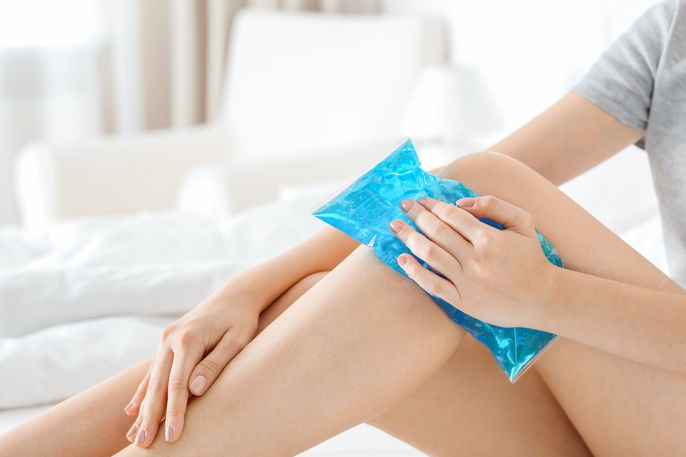Knee pain relief can be achieved with home remedies such as applying cold compresses, massage or exercises that help to strengthen the knee muscles.
However, in cases where the pain doesn't go away within 5 days, it's important to consult a doctor for assessment to help identify the cause. In cases of moderate to severe pain, medication may be prescribed.
Knee pain can be caused by sprains, meniscus injuries, torn ligaments, arthritis, arthrosis, cysts, changes in the patella or tendonitis. Because many different conditions can cause knee pain, it is important to identify the cause so that the best treatment can be recommended. Treatment may require involve physiotherapy, medication and, in some cases, surgery.

Natural options
Some natural ways to achieve knee pain 8 relief include:
1. Rest
Resting the affected knee and avoiding high impact activities or activities that cause direct pressure on the knee joint can help relieve knee pain.
Rest helps the knee to recover and heal, as well as relieve the pain and discomfort that can occur with movement.
2. Apply cold compresses
Applying cold compresses to the affected knee for 15 minutes at a time can help to relieve inflammation and reduce swelling related to meniscus problems, sprains, tendonitis or muscle strain. It can be applied 2-3 times a day, at different times, such as in the morning, afternoon and evening.
When applying the cold compress, it is important to be careful not to burn the skin, and to therefore wrap the compress with clean cloth before applying it to the knee.
3. Apply warm compresses
Warm compresses can also be applied to relieve pain in cases of arthritis or chronic knee pain that lasts for over 6 weeks. The heat can help to increase blood flow to the area, relax the muscles and relieve stiffness in the joint.
The warm compress can be prepared by adding hot water to a thermal bag or heating up a bag bean compress in the microwave. Wrap them in a clean towel and apply to the affected area for about 10 to 15 minutes, 2 to 3 times a day.
It is important to ensure the compress is not too hot, as they can severely burn the skin.
4. Elevation
Elevating the leg above heart height helps to stimulate blood circulation, stimulate the lymphatic system and provides relaxation. All of these are essential factors in reducing swelling in the affected knee.
An easy way to elevate your leg is to lie on your bed and place your leg on the headboard or to rest your leg on high pillows.
5. Massage
Massaging the knee with an anti-inflammatory gel or ointment, like topical diclofenac, can also help combat knee pain.
You should massage the ointment into the knee until the product is completely absorbed into the skin. Treatment instructions should be as indicated by your doctor.
6. Wear a knee brace
Wearing a knee brace helps to reduce swelling in the knee as well as immobilize the joint. They help to provide greater stability and balance when weight-bearing.
Knee braces can be worn after showering and kept on throughout the day.
It is important that the knee brace fits snugly to the skin for it to have the expected effect, as wearing a loose knee brace may not be therapeutically beneficial.
7. Postural drainage
If your knee is swollen, postural drainage may be recommended.
To do this, simply lie on the bed or sofa, keeping your legs higher than your torso by placing a cushion under your feet and knees to make you feel more comfortable.
8. Stretching exercises
Stretching exercises can also help reduce knee pain. To do this, you should gently stretch the leg of the affected knee, by bending the knee and holding your ankle.
Remedies for knee pain
Remedies to relieve knee pain should be oriented by your doctor according to the intensity of the symptoms, physical examination and imaging tests, such as X-ray, MRI or ultrasound. This assessment will help to identify the cause of the knee pain, which will help to orient treatment.
The doctor may prescribe anti-inflammatory drugs such as ibuprofen or diclofenac to treat swelling and analgesics, such as acetaminophen, to reduce pain.
In some cases, in addition to medication, physiotherapy sessions and surgery may be recommended, depending on the cause of the pain.






























